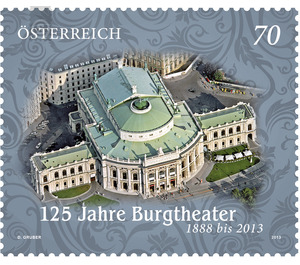125 years - Austria / II. Republic of Austria 2013 - 70 Euro Cent
Theme: Art & Culture
| Country | Austria / II. Republic of Austria |
| Issue Date | 2013 |
| Face Value | 70.00 |
| Edition Issued | 400,000 |
| Printing Type | offset |
| Stamp Type | Commemorative |
| Item Type | Stamp |
| Chronological Issue Number | 2438 |
| Chronological Chapter | OOS-OE2 |
| SID | 174993 |
| In 64 Wishlists | |
The Burgtheater, located on the elegant Viennese Ringstrasse opposite the Town Hall and designed in neo-Baroque style by Gottfried Semper and Karl Freiherr von Hasenauer, is the largest German-speaking theater and is also one of the most important theaters in Europe. Throughout its eventful history, the theater has been known by different names, first "k.k. Theater next to the castle ", then until 1918" k.k. Hof-Burgtheater "and since then simply" Burgtheater ". In Vienna itself, it is often called "the castle" in a short and reverential way, and the ensemble members are generally known as "the castle actors". Since 2009, the German director and director Matthias Hartmann directs the famous house. Exactly 125 years ago, on October 14, 1888, the Burgtheater was ceremoniously opened with Franz Grillparzer's drama fragment "Esther" and Friedrich von Schiller's famous work "Wallenstein's Camp". Österreichische Post AG is honoring this great anniversary with its own special stamp, whose motif shows the impressive bird's-eye view of the building. The Viennese population has always had a special relationship with "their castle", the theater was then, as now, always in the light of public attention. As early as the 19th century, the rumors and scandals surrounding the Burgtheater were among the most popular Viennese themes. In the castle, the various social classes - ie bourgeoisie and nobility - could meet, although their places were once strictly separated. The castle actors "connected" these two estates and thereby enjoyed a particularly high social status. Today, a large part of the actors and theater staff are no longer from Austria, but from Germany or other countries; Nevertheless, many Burgtheater are accepted by the Viennese as Viennese and worshiped as "their actors". A prominent name is, for example, the German Michael Heltau, whose inimitable language is considered to be one of the greatest Viennese song interpreters. Speaking of language: The so-called "Burgtheaterdeutsch", that rhetoric that is spoken on the stage of the Burgtheater, most Viennese feel like music in their ears. It is certain that this term is used for a particularly well-spoken variant of the German language. The "Burgtheaterdeutsch" was once an artificial language and served to enable viewers to understand the actors who came from different regions of the German-speaking world under the less than ideal acoustic circumstances of the Burgtheater.


